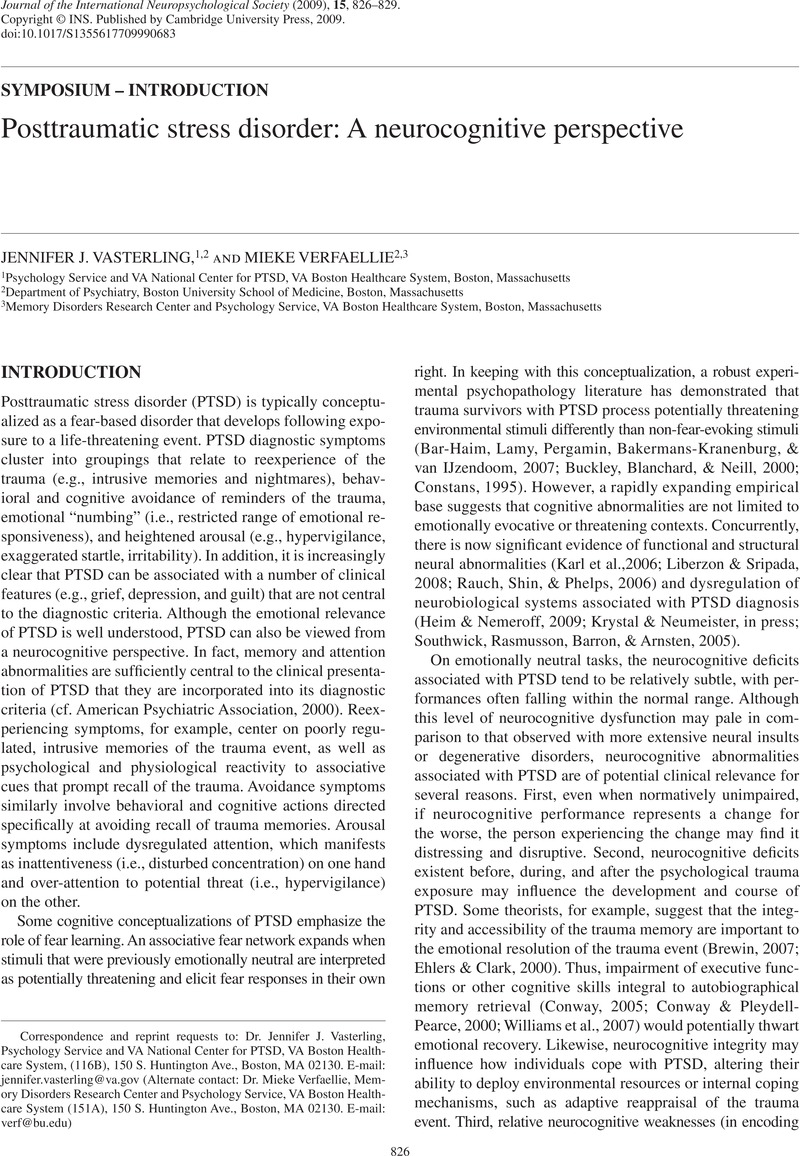Crossref Citations
This article has been cited by the following publications. This list is generated based on data provided by Crossref.
Gould, Felicia
Clarke, Jennifer
Heim, Christine
Harvey, Philip D.
Majer, Matthias
and
Nemeroff, Charles B.
2012.
The effects of child abuse and neglect on cognitive functioning in adulthood.
Journal of Psychiatric Research,
Vol. 46,
Issue. 4,
p.
500.
Bogdanova, Yelena
and
Verfaellie, Mieke
2012.
Cognitive Sequelae of Blast-Induced Traumatic Brain Injury: Recovery and Rehabilitation.
Neuropsychology Review,
Vol. 22,
Issue. 1,
p.
4.
Swick, Diane
Honzel, Nikki
Larsen, Jary
Ashley, Victoria
and
Justus, Timothy
2012.
Impaired Response Inhibition in Veterans with Post-Traumatic Stress Disorder and Mild Traumatic Brain Injury.
Journal of the International Neuropsychological Society,
Vol. 18,
Issue. 5,
p.
917.
Dolan, Sara
Martindale, Sarah
Robinson, Jennifer
Kimbrel, Nathan A.
Meyer, Eric C.
Kruse, Marc I.
Morissette, Sandra B.
Young, Keith A.
and
Gulliver, Suzy Bird
2012.
Neuropsychological Sequelae of PTSD and TBI Following War Deployment among OEF/OIF Veterans.
Neuropsychology Review,
Vol. 22,
Issue. 1,
p.
21.
Swick, Diane
Honzel, Nikki
Larsen, Jary
and
Ashley, Victoria
2013.
Increased response variability as a marker of executive dysfunction in veterans with post-traumatic stress disorder.
Neuropsychologia,
Vol. 51,
Issue. 14,
p.
3033.
Horner, Michael David
Mintzer, Jacobo E.
Turner, Travis H.
Edmiston, Keith R.
and
Brawman-Mintzer, Olga
2013.
Attentional functioning in patients with posttraumatic stress disorder: a preliminary study.
CNS Spectrums,
Vol. 18,
Issue. 2,
p.
90.
Lindemer, Emily R.
Salat, David H.
Leritz, Elizabeth C.
McGlinchey, Regina E.
and
Milberg, William P.
2013.
Reduced cortical thickness with increased lifetime burden of PTSD in OEF/OIF Veterans and the impact of comorbid TBI.
NeuroImage: Clinical,
Vol. 2,
Issue. ,
p.
601.
Esterman, Michael
DeGutis, Joseph
Mercado, Rogelio
Rosenblatt, Andrew
Vasterling, Jennifer J.
Milberg, William
and
McGlinchey, Regina
2013.
Stress-Related Psychological Symptoms Are Associated with Increased Attentional Capture by Visually Salient Distractors.
Journal of the International Neuropsychological Society,
Vol. 19,
Issue. 7,
p.
835.
Norris, Jacob N.
Sams, Richard
Lundblad, Peter
Frantz, Earl
and
Harris, Erica
2014.
Blast-related mild traumatic brain injury in the acute phase: Acute stress reactions partially mediate the relationship between loss of consciousness and symptoms.
Brain Injury,
Vol. 28,
Issue. 8,
p.
1052.
Pang, E W
Sedge, P
Grodecki, R
Robertson, A
MacDonald, M J
Jetly, R
Shek, P N
and
Taylor, M J
2014.
Colour or shape: examination of neural processes underlying mental flexibility in posttraumatic stress disorder.
Translational Psychiatry,
Vol. 4,
Issue. 8,
p.
e421.
Honzel, Nikki
Justus, Timothy
and
Swick, Diane
2014.
Posttraumatic stress disorder is associated with limited executive resources in a working memory task.
Cognitive, Affective, & Behavioral Neuroscience,
Vol. 14,
Issue. 2,
p.
792.
DeGutis, Joseph
Esterman, Michael
McCulloch, Bay
Rosenblatt, Andrew
Milberg, William
and
McGlinchey, Regina
2015.
Posttraumatic Psychological Symptoms are Associated with Reduced Inhibitory Control, not General Executive Dysfunction.
Journal of the International Neuropsychological Society,
Vol. 21,
Issue. 5,
p.
342.
Hermelink, K.
Voigt, V.
Kaste, J.
Neufeld, F.
Wuerstlein, R.
Buhner, M.
Munzel, K.
Rjosk-Dendorfer, D.
Grandl, S.
Braun, M.
von Koch, F. E.
Hartl, K.
Hasmuller, S.
Bauerfeind, I.
Debus, G.
Herschbach, P.
and
Harbeck, N.
2015.
Elucidating Pretreatment Cognitive Impairment in Breast Cancer Patients: The Impact of Cancer-related Post-traumatic Stress.
JNCI Journal of the National Cancer Institute,
Vol. 107,
Issue. 7,
p.
djv099.
Mouchabac, Stéphane
El-Hage, Wissam
and
Ferreri, Florian
2016.
La mémoire intrusive dans le trouble de stress post-traumatique : apport de la neuroimagerie.
Annales Médico-psychologiques, revue psychiatrique,
Vol. 174,
Issue. 10,
p.
848.
Seal, Karen H.
Bertenthal, Daniel
Samuelson, Kristin
Maguen, Shira
Kumar, Sant
and
Vasterling, Jennifer J.
2016.
Association between mild traumatic brain injury and mental health problems and self-reported cognitive dysfunction in Iraq and Afghanistan Veterans.
Journal of Rehabilitation Research and Development,
Vol. 53,
Issue. 2,
p.
185.
Mahabir, Megan
Ashbaugh, Andrea R.
Saumier, Daniel
and
Tremblay, Jacques
2016.
Propranolol's impact on cognitive performance in post-traumatic stress disorder.
Journal of Affective Disorders,
Vol. 192,
Issue. ,
p.
98.
Bailey, Erin
2017.
Encyclopedia of Clinical Neuropsychology.
p.
1.
Silverberg, Noah D.
Wojtowicz, Magdalena
Bui, Eric
Wershba, Rebecca
Zafonte, Ross
Laifer, Lauren M.
Simon, Naomi M.
and
Iverson, Grant L.
2017.
Contribution of Perceived Cognitive Functioning to Quality of Life in Service Members and Veterans With Posttraumatic Stress Disorder.
Journal of Traumatic Stress,
Vol. 30,
Issue. 3,
p.
318.
Swick, Diane
and
Ashley, Victoria
2017.
Enhanced Attentional Bias Variability in Post-Traumatic Stress Disorder and its Relationship to More General Impairments in Cognitive Control.
Scientific Reports,
Vol. 7,
Issue. 1,
Newman, Jennifer
and
Marmar, Charles
2017.
Executive Functions in Health and Disease.
p.
487.



